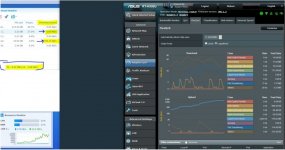slidermike
Regular Contributor
Dave,Ok, so the final stats would come from:
All 3 commands together should increment their counts in unison when picking up traffic from the iptables rule.Code:tc -s class show dev eth0 parent 1: | grep -A2 "htb 1:14"
can you sanity check me?
WAN - AX86u <vpn client> Synology
ax86u as a client to nordvpn @ 167.88.10.181
vpn outbound traffic classified as "Learn-from-Home" - WORKING
PBR to force Synology NAS traffic over the vpn on ax86u.
When I look at the Synology traffic on the NAS itself and a side by side of the FlexQoS, the inbound values do not match in the gui.
Also, how can I tell FlexQoS to put the Nordvpn traffic Inbound to the router into the same "Learn-from-Home" class as it now is outbound?
In the included screen capture the Synology NAS is pulling data down at roughly 8.5MB/s (hopefully through the vpn tunnel on the ax86u) but I am having a difficult time determining which class the AX86U vpn inbound traffic is flowing through in the FlexQoS gui.
I guess what I am really asking is:
1) Can I and how do I configure FlexQoS to put the ax86u's client vpn download traffic into a specific class "Learn-from-Home"?
Thank you
Mike


